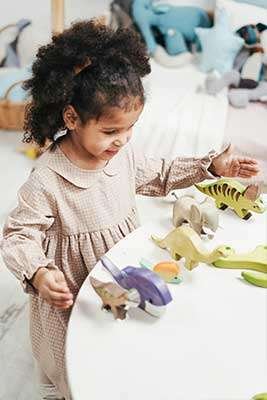It’s no secret that most kids dread math. However, with the right tools and techniques, you can make math a fun learning experience for your children that they will love! Here are ten of our favorite ways to do just that. Keep reading for some great ideas!
Make math fun by turning it into a game.
Play number bingo, dice games, and other math-related games to make learning fun. Turn it into a family activity! You can play number bingo as a family, or you can get everyone involved in a dice game.

Print out our free printable math fact bingo! To play, have your child roll the die and cover the corresponding number on their bingo sheet. Continue playing until they get a bingo!
Another Game: Play “I spy” with math. Have your child give you a clue of the things around them that equal a specific number. For example, if the number they landed on was “3”, their clue might be, “Three ants are crawling on our picnic table.”
Name a number and have your child write as many items as they can think of that equal that number. For example, if you say “8”, they might list eight cars going down the road, eight children playing in a park, etc.
Create a “story problem” to help your child learn the different steps involved in solving story problems, such as which operation to use or what information to give. Example: “If you have six math books and your friend has five math books, how many math books do you both have?”
Use real-life examples to make math easier for kids to understand.
Help your child understand the value of money by showing them how much fun they can have when they save up for a new toy. For example, if your child wants a $30 toy, you can explain that if they save up for two months (by putting away the change they get from birthday and holiday gifts, allowance, etc.), they will have $60 to buy the toy.
Create a chart where you and your child write down how long it takes to complete a household chore and the amount of money you would make if you were paid per hour. Your child will begin to understand the value of working and how saving for a goal (such as a toy) can impact their life.
Create worksheets for your child to complete with real-life math problems on them. For example, if they just went grocery shopping with you, ask them how much they spent, how much change they got back from the cashier, and the cost of different items.
Use colorful visuals to help explain concepts.
Colorful visuals such as charts and graphs can help children understand abstract concepts like fractions. For example, you could show your child a half-bushel of potatoes and a whole bushel of tomatoes and ask them how many half-bushels they would need to fill one whole bushel.
Get a poster board and create a fun infographic to help explain how many inches, centimeters, or feet are in an inch. You can use whatever measurements are easiest for your family to understand, but using visuals will help kids better understand the concept.
One of our favorite infographic posters is the “Math Cheat Sheet.” It has basic math formulas that are commonly used in everyday life, including how to do different conversions.
Create a visual representation of the concept you are trying to teach your child. For example, if you are attempting to explain the concept of an obtuse angle to your child, you might draw the object on a piece of paper or show them an image.
Draw shapes on a large piece of paper and have your child identify different patterns within the shapes. For example, if you draw an octagon, they might notice that there are four sides with 90-degree angles inside of it.
Use fun math journals to help build problem-solving skills in kids.

Keep a math journal where your child writes down how many of a certain object they see around them or what different shapes they can find.
You could also ask them about the number of people in your family, how long it takes to complete simple household chores, etc.
Help your child understand how fractions work by having them cut up pieces of paper with odd numbers on them and fold them to make evens.
For example, if you cut one piece of paper in half and the other three pieces in thirds, your child will understand that two halves equal one whole and three thirds equal a whole.
Use manipulatives to help explain concepts.
Use manipulatives. Draw shapes on bingo cards with dry-erase markers, have your child match the correct shape to the correct number, and have them color in a box when they get a bingo.
Play card games with your child where you are drawing different shapes and asking them to identify which shape it is. Or, play fun physical games where your child is putting together puzzles made up of basic shapes like circles and rectangles.
Set up a scavenger hunt where you hide shapes around your house and have your child identify their shape before coming back to the start.
Find alternative ways to help kids understand abstract or complex concepts.
Kids often struggle with abstract concepts, so it is important to find alternative ways they can learn and understand.
For example, if you are trying to explain how a microscope works, take your child to a science museum and show them microscopes that they can look into. Offer different ways that children can solve problems.
Instead of just asking your child how they would solve a problem, try giving them different options as well.
For example, suppose you were teaching your child about angles in geometry. In that case, you might draw an eye on a piece of paper and show them that when an eye is looking straight ahead, it is called zero degrees, but when the eye is open more one way than another, that angle would be different.
Let children use their creativity and imagination when solving problems.

Kids often have a hard time understanding abstract concepts, so allowing them to use their imagination and creativity to solve problems can help and encourage problem-solving skills.
For example, if you were teaching your child about volume, they might think of the biggest container they could find at home and see how much it would hold.
If you are teaching your child about estimation, have them guess how many objects there are in a classroom or living room and then count them together with the teacher or parent. Estimating this way will help children understand that estimates can be very close or off by a little bit, but not exact every time.
Reward children for their efforts.
Children feel better about themselves when they are praised for their efforts, even if they didn’t succeed in the end.
For example, if your child was trying to find out how many feet were in an inch and they were off by a little bit, tell them that they are close! Then, you can go over different ways to find the correct answer.
Use other resources.
Find resources that you think will appeal to your child, whether YouTube videos or apps on their iPad. There are so many different learning tools out there, so find what works best for your child’s interests and learning style.
Even though many young children seem uninterested in learning skills like math or logic at first, there are many different methods that can help them understand these abstract concepts. With patience and creativity, your child will learn the basics even if they aren’t catching on right away.
For example, there are many apps that can help kids learn about fractions. These apps allow children to drag the different pieces of a pie together and see what fraction that piece would be.
Many YouTube videos break down math concepts into fun music or lyric videos so that even young children might enjoy watching them.
Work one-on-one with your child to help them understand confusing concepts.

If none of the above strategies seem to work for your child, you can always try meeting them where they are and working one-on-one to figure out how they learn best.
For example, if your child is struggling with subtraction, try having them learn subtraction by rote (memorizing the steps of addition and then doing the same for subtraction).
Kids need to know that even though they might not understand something right away, things will eventually make sense. After all, learning new skills is a process; no one remembers everything on the first try!
Conclusion.
Your child’s teacher will likely teach these concepts in school, but you can also help them learn at home. Be patient and find new ways to explain things until your child understands the concept fully.
Do you have any tips for teaching young children complicated concepts? Leave a comment below!

Meet Brenda Tillman: your go-to expert in Cognitive Behavioral Therapy! Not only is she a seasoned therapist, but she’s also a passionate mom blogger who never misses a beat. Dive deep into her insightful blogs, backed by her extensive coursework in Parenting Skills, Learning, and Education. Brenda’s heartwarming family – a son, two daughters, and their adorable pets – often take center stage in her writings. From parenting hacks and relationship tips to health & fitness nuggets, Brenda has been enlightening her readers for over half a decade. Stick around, and you’re bound to discover gems from a mom who wears many hats with grace!
Reviewed By: Joanna Perez and Marcella Raskin
Edited By: Lenny Terra
Fact Checked By: Gabrielle J. Smith
Photos Taken or Curated By: Matthew Mansour